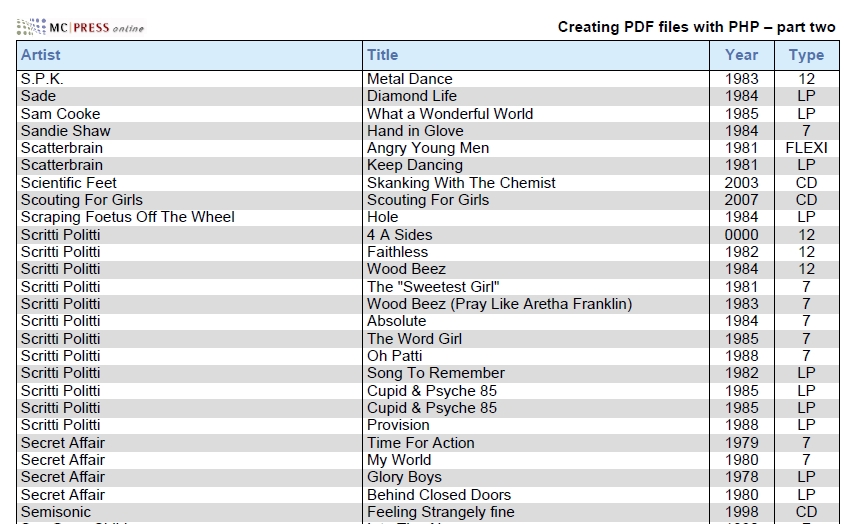Add more tricks to your FPDF toolbox and learn how to control "overflow" printing.
In my last TechTip, I introduced you to FPDF. This time, I will dig a little deeper into this great tool and provide you with a tip that lets you print out data and at the same time use the built-in overflow control in the FPDF class.
So sit back and let your thoughts fly back to the good ol' days of the RPG cycle with 1P and LR.
Before I start, let me point out that the way I create my PHP scripts is by finding something I like on the Web, modifying it to my needs, and republishing the code. I tell you this because if you search the Web for FPDF examples, you are likely to find some that have the same functionality as mine, and I do not want you to think I am just a copycat—or am I? But then again, aren't we all? That's the beauty of programming: write some code and publish it, and maybe someone will extend your idea and publish a new version.
Now, if you have not read Part I of this tip, please read it to avoid getting confused.
Feeding Data to the FPDF Example
Normally, when you create a PDF file using FPDF, you'll need a data source to feed your script. At first, I planned to use a MySQL table, but I changed my mind and instead I used a CSV file.
The reason is that CSV is much easier to get started with, and if you want to use MySQL as a data feeder, it is very easy to replace the reading of the CSV file with the reading of the MySQL table.
Header() and Footer(): The RPG Cycle Revisited?
Inside the FPDF class, you'll find two empty functions called Header and Footer (and yes, they are case-sensitive). To use these functions in your script, you have to inherit them from the FPDF class, which is done by using the Extends keyword in PHP. This will allow you to access the functions (methods in OO), and you can "build" your own functionality into them. As they are already empty, everything you do will be what they do. In an object-oriented world, this is a common thing to do, but for old RPG programmers (like me), it is pretty hard to understand, and every time I try to explain it, I always wonder if I am explaining it correctly.
But to make a long story short, Header and Footer are called automatically when the limit that triggers the page break is reached. I will not mention 1P and LR—no, no—but I suppose you get the picture. If you want to change the new page trigger, use the SetAutoPageBreak. As a default, the trigger is 2 centimeters from the bottom.
Here comes a hard one: when you see the $this variable, remember that it is always set by PHP for the current object you are working with. This gives you complete access to all the object's variables, and you use the $this variable when working with local variables inside an object's function.
If you think what you just read is total nonsense, have a look at the code below. Even better, copy/paste it into a PHP file and run it on your own Web server to see for yourself.
<?php
//=========================================================================
//
// MC Press Online - Creating PDF files with PHP—part two
//
// -- Print list with Header/Footer
//
// Ex 1
//=========================================================================
include_once("../fpdf/fpdf.php"); // Include the fpdf class
// Inherited from FPDF class (1)
class PDF extends FPDF
{
// Page header (2)
function Header()
{
//Logo
$this->Image('images/php.gif',10,8,33);
//Arial bold 15
$this->SetFont('Arial','B',15);
// Move to the right
$this->Cell(60);
// Print the Title
$this->SetFillColor(220);
$this->Cell(110,10,'Creating PDF files with PHP—part two',1,0,'C',true);
// Line break
$this->Ln(20);
}
// Page footer (3)
function Footer()
{
//Position at 1.5 cm from bottom
$this->SetY(-15);
// Set font
$this->SetFont('Arial','I',6);
// Page number
$this->Cell(0,10,'Page '.$this->PageNo().' of {nb}',0,0,'C');
}
}
//Instanciation of inherited class (4)
$pdf=new PDF();
$pdf->AliasNbPages();
$pdf->SetAutoPageBreak( true, 50); // break 5 cm from bottom
$pdf->AddPage();
$pdf->SetFont('Times','',12);
// Print some data (5)
for($i=1;$i<=100;$i++) {
$pdf->Cell(0,10,'This is line number '.$i,0,1);
}
// Close output
$pdf->Output();
?>
Because the lack of space, I will not comment every line, but here is what happens.
At (1), the FPDF class is extended to be able to access the Header and Footer functions. Then, at (2), we create the Header function as we always do in PHP. We use the $this variable to "glue" various FPDF functions to the PDF object so that when the Header method is triggered, all the code added will be printed out. We do the same thing at (3) with the Footer method. At (4), we create the $PDF object, and from then on, everything is business as usual. At (5), we create a for loop and write out the data. This is where the magic happens. Every time the trigger point is reached (in my example, 5 centimeters from the bottom), the Header and Footer methods are fired, creating a nice PDF file.
Feed Me Some Data
OK, if you've been able to follow along, you now get the picture.
In the next example, I have made a subset from my music collection (once again) with all the bands starting with S. I have put artist, title, release year, and type into a CSV file. There are about 210 entries. When printed, the list will look like the one in Figure 1.
Figure 1: My PDF file looks like this! (Click image to enlarge.)
I will not show the code for the full script here, but of course you can download all the files and the directory structure used in this tip here. The script follows the same structure as the code above except that it receives its input from the already-mentioned CVS file.
Wrapping It All Up
Once again, I really hope that this tip gives you something to add to your PHP toolbox. In my next tip, I will show you how to use templates to simplify the creation of logos, specially designed forms, and such.
As always, happy PHPing.





















 More than ever, there is a demand for IT to deliver innovation. Your IBM i has been an essential part of your business operations for years. However, your organization may struggle to maintain the current system and implement new projects. The thousands of customers we've worked with and surveyed state that expectations regarding the digital footprint and vision of the company are not aligned with the current IT environment.
More than ever, there is a demand for IT to deliver innovation. Your IBM i has been an essential part of your business operations for years. However, your organization may struggle to maintain the current system and implement new projects. The thousands of customers we've worked with and surveyed state that expectations regarding the digital footprint and vision of the company are not aligned with the current IT environment. TRY the one package that solves all your document design and printing challenges on all your platforms. Produce bar code labels, electronic forms, ad hoc reports, and RFID tags – without programming! MarkMagic is the only document design and print solution that combines report writing, WYSIWYG label and forms design, and conditional printing in one integrated product. Make sure your data survives when catastrophe hits. Request your trial now! Request Now.
TRY the one package that solves all your document design and printing challenges on all your platforms. Produce bar code labels, electronic forms, ad hoc reports, and RFID tags – without programming! MarkMagic is the only document design and print solution that combines report writing, WYSIWYG label and forms design, and conditional printing in one integrated product. Make sure your data survives when catastrophe hits. Request your trial now! Request Now. Forms of ransomware has been around for over 30 years, and with more and more organizations suffering attacks each year, it continues to endure. What has made ransomware such a durable threat and what is the best way to combat it? In order to prevent ransomware, organizations must first understand how it works.
Forms of ransomware has been around for over 30 years, and with more and more organizations suffering attacks each year, it continues to endure. What has made ransomware such a durable threat and what is the best way to combat it? In order to prevent ransomware, organizations must first understand how it works. Disaster protection is vital to every business. Yet, it often consists of patched together procedures that are prone to error. From automatic backups to data encryption to media management, Robot automates the routine (yet often complex) tasks of iSeries backup and recovery, saving you time and money and making the process safer and more reliable. Automate your backups with the Robot Backup and Recovery Solution. Key features include:
Disaster protection is vital to every business. Yet, it often consists of patched together procedures that are prone to error. From automatic backups to data encryption to media management, Robot automates the routine (yet often complex) tasks of iSeries backup and recovery, saving you time and money and making the process safer and more reliable. Automate your backups with the Robot Backup and Recovery Solution. Key features include: Business users want new applications now. Market and regulatory pressures require faster application updates and delivery into production. Your IBM i developers may be approaching retirement, and you see no sure way to fill their positions with experienced developers. In addition, you may be caught between maintaining your existing applications and the uncertainty of moving to something new.
Business users want new applications now. Market and regulatory pressures require faster application updates and delivery into production. Your IBM i developers may be approaching retirement, and you see no sure way to fill their positions with experienced developers. In addition, you may be caught between maintaining your existing applications and the uncertainty of moving to something new. IT managers hoping to find new IBM i talent are discovering that the pool of experienced RPG programmers and operators or administrators with intimate knowledge of the operating system and the applications that run on it is small. This begs the question: How will you manage the platform that supports such a big part of your business? This guide offers strategies and software suggestions to help you plan IT staffing and resources and smooth the transition after your AS/400 talent retires. Read on to learn:
IT managers hoping to find new IBM i talent are discovering that the pool of experienced RPG programmers and operators or administrators with intimate knowledge of the operating system and the applications that run on it is small. This begs the question: How will you manage the platform that supports such a big part of your business? This guide offers strategies and software suggestions to help you plan IT staffing and resources and smooth the transition after your AS/400 talent retires. Read on to learn:
LATEST COMMENTS
MC Press Online